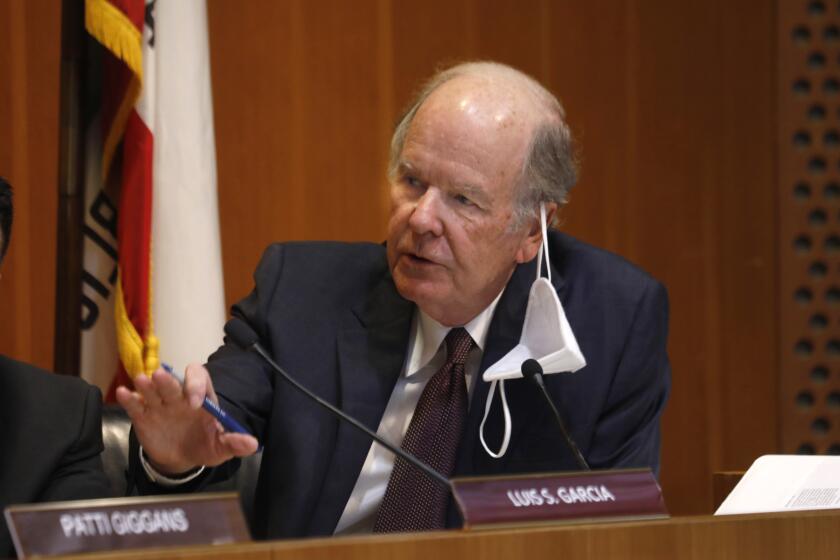As climate change challenges home insurers, an ‘uninsurable future’ looms

- Share via
You may notice a new look and feel here! We have merged our two morning newsletters and are excited to get you the most important news, features and recommendations from the L.A. Times and beyond, in a sleeker and faster presentation.
Good morning. It’s Thursday, Sept. 7. Here’s what you need to know to start your day.
- Insurers are leaving California
- Spectrum and Disney fight over the future of television
- Explore the best bars in Long Beach
- And here’s today’s e-newspaper
Sign up for Essential California
The most important California stories and recommendations in your inbox every morning.
You may occasionally receive promotional content from the Los Angeles Times.
For the record:
5:43 p.m. Sept. 14, 2023An earlier version of this newsletter described the FAIR plan as state-sponsored. It was created by the state, but is managed by a private association of state-licensed insurers.
As climate change challenges home insurers, an ‘uninsurable future’ looms
To kick off the spiffy new version of this newsletter, I want to talk about your insurance policy.
(Wait! Don’t go! There’s a treat waiting for you at the end.)
Earlier this year two major insurers, Allstate and State Farm, announced they would stop offering new policies for properties in the Golden State. Officials from State Farm — the state’s longtime top home insurer — cited “rapidly growing catastrophe exposure and a challenging reinsurance market.”
Farmers recently announced it was laying off 11% of its workforce and tempering its growth goals in California.
The companies indicate they’re responding to what scientists have been telling us: Human-caused climate change is intensifying wildfires and other environmental disasters. Covering homes in increasingly dry, fuel-rich forests, on cliffs that don’t stay put and at the edge of the coast as sea levels rise is a business that’s only getting riskier.
“This could be the beginning of a market collapse that would leave millions stranded without affordable insurance as their homes burned to the ground,” Times business reporter Sam Dean wrote this summer.
These anxieties in the insurance market have been a long time coming, and enrollment in the FAIR plan, which covers properties other insurers refuse to, has more than doubled since 2018.
But critics have also questioned whether there’s more to the companies’ decision to step back from states where the effects of climate change are becoming more apparent.
Are they using climate change as “an excuse to escape from … regulatory protections,” as Consumer Watchdog founder Harvey Rosenfield told Bloomberg?
I spoke with Dave Jones, director of UC Berkeley’s Climate Risk Initiative and the state’s former insurance commissioner, to learn more about these high-profile retreats and what they could mean for Californians. He acknowledged the debates about insurers’ motives and whether any “near-term policy changes [could] make some difference at the margin,” but cautioned that focusing on that part of the story could make us “lose sight of the forest for the trees.”
“The forest is climate change,” he told me.
Jones and other experts who consider environmental risks argue that this should be a wake-up call for government leaders. He noted Florida as an example, where insurers enjoy many perks that they don’t have in California, but are still leaving the state.
“Insurance isn’t magic,” Jones said. “Insurers are rational economic actors … in business to make money. And in some parts of the United States for some risks, they’re deciding that there simply isn’t a price high enough for them to make sense insuring that particular risk in that particular geography.”
Jones warned that the path toward an “uninsurable future” we’re currently on could eventually affect the housing market, though it’s not inevitable. If insurance premiums continue to climb and more people can’t afford them and their mortgages, they could default and lose their homes.
“I’m not suggesting that we’re there yet,” he noted, “but it definitely bears paying attention to, because that’s a potential path of transmission of this risk in ways that could have negative consequences for our financial system.”
So what else should the state and federal government be doing to avoid the “uninsurable future” Jones warns about? He shared a few ideas:
- The Federal Reserve and other federal financial regulators need to get serious about assessing the risks climate change poses to the financial system. That’s something the Fed just recently started to do, though critics say their efforts are weak and well behind other countries’ efforts.
- State and federal leaders should invest more in forest management, especially prescribed burns. Jones said officials finally recognized that “a century and a half of fire suppression has resulted in forests choked with fuel.” Prescribed burns are key to reducing the risks of fires growing to out-of-control infernos, and Jones would like to see insurers factor such risk reduction into their assessments.
- Most significant, Jones said, is the need to dramatically and quickly cut the human-made emissions that affect our environment.
“This is only going to get worse if we don’t stop using fossil fuels and reduce greenhouse gas emissions,” he said. “There has been some important progress made by California … but we and every other state need to do more.”
Wow, you made it! Nicely done. As promised, please enjoy this visual treat.
Today’s top stories

Disney vs. Spectrum: A battle for the future of television
- ESPN, ABC stations, FX and other Disney-owned channels are part of a high-stakes blackout affecting 14.8 million Charter Spectrum customer homes.
- Amid Charter Spectrum’s feud with Disney, there are options for watching blacked-out programming. Here are a few ideas.
- A plague on both Disney and Spectrum for treating their customers like crap, Michael Hiltzik writes.
On Dianne Feinstein and her open Senate seat
- In the final chapter of a long career, Sen. Dianne Feinstein’s private affairs are being scrutinized like never before. Her daughter spoke about the growing publicity around the fight over the family’s millions in an exclusive interview with The Times.
- Schiff and Porter are dominating the race for the Senate seat Feinstein will vacate at the end of this term, according to a new UC Berkeley Institute of Governmental Studies poll co-sponsored by the Los Angeles Times.
Viruses and new vaccines
- One of the new COVID vaccines that could come out next week works well against an upstart Omicron subvariant, a reassuring sign, experts say.
- A Centers for Disease Control and Prevention health advisory notes elevated cases of respiratory syncytial virus in parts of the Southeastern U.S.
More big stories
- More than 40,000 eviction notices have gone out in L.A. just this year, and not just in poor communities.
- The first rural Assembly speaker in a generation is working to unite Democrats in a Capitol dominated by big-city liberals.
- A San Bernardino County Superior Court judge ruled to approve a temporary restraining order against Chino Valley schools’ transgender “parent notification policy.”
- LAPD seeks to fire two officers in a gang unit suspected of turning off body cameras.
- After the death of Russia’s Wagner chief, what happens to his mercenary army?
- This Indian family tried to immigrate to the U.S. legally. They ended up separated and in legal limbo.
- Meet the brash, controversial former surgeon shaking up Taiwan’s presidential race.
Get unlimited access to the Los Angeles Times. Subscribe here.
Commentary and opinions
- Jackie Calmes: Coming soon: ‘Impeachment theater’ and Kevin McCarthy’s bow to the MAGA crazies
- LZ Granderson: Yes, Texas Democrats and Republicans are cooperating. No, it’s not the apocalypse
- Editorial board: More money for buildings won’t solve L.A.’s juvenile probation woes
- Gustavo Arellano: What do Iowa and California have in common? More than you’d think
Today’s great reads
Love, Peace & Spades highlights a community staple in Black L.A. that’s having a renaissance. Black L.A. residents have long searched for casual-sportive places to commune, even connecting strangers who otherwise wouldn’t have had a chance to interact. Now, they’ve found one way to do just that via Black America’s favorite pastime: spades.
Other great reads
- Lavender for love, salt for cleansing: A day in the life of an L.A. astrologer and witch
- Cruising Santa Monica Boulevard with the fetish photographer who shot L.A.’s male hustlers
How can we make this newsletter more useful? Send comments to essentialcalifornia@latimes.com.
For your downtime

Going out
- 🐏 Who’s your favorite NFL mascot? Our guide to seeing them at every stadium
- 🏈 The ultimate SoCal college football sports bar guide: Find out where to watch your team
- 🥃 Have a drink in Long Beach: A local’s list of the absolute best bars
Staying in
- 📺 TV for every taste this fall: Returning series, game shows, documentaries and Trump
- 🧑🍳 Here’s a recipe for peaches, plums and late-summer berries
- ✏️ Get our free daily crossword puzzle, sudoku, word search and arcade games.
And finally ... from our archives
On Sept. 7, 1979, ESPN debuted on American television, making sports television, for the first time, a round-the-clock, round-the-calendar proposition.
When the network turned 20 in 1999, The Times wrote a special report about the four-letter word that changed sports and revolutionized sports television into a media behemoth that overshadows and overwhelms virtually everything it covers.
Have a great day, from the Essential California team
Ryan Fonseca, reporter
Elvia Limón, multiplatform editor
Kevinisha Walker, multiplatform editor
Laura Blasey, assistant editor
Check our top stories, topics and the latest articles on latimes.com.
Sign up for Essential California
The most important California stories and recommendations in your inbox every morning.
You may occasionally receive promotional content from the Los Angeles Times.









